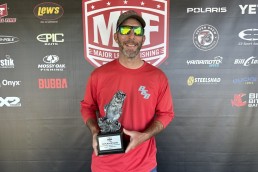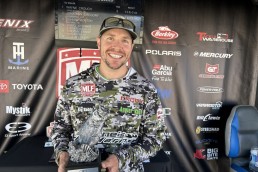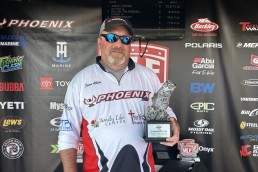Bassmaster Classic Bracket – Is This What The Future Of Professional Fishing Looks Like?
As he fished from the front deck of his bass boat, breeze rippling his jersey, Kevin VanDam reflected on a career that has seen all the changes of format that B.A.S.S. has thrown at anglers in the modern era: the MegaBucks hole-style events, the E-50’s that morphed into the current Elite Series, and so on. He had high praise for the tournament in which he was competing during the final, championship, round – the Bassmaster Classic Bracket.
Perhaps it’s easy to be high on a platform that has just facilitated your 23rd career win, especially when VanDam has a lot of experience with match play, given his involvement with Major League Fishing (the comparisons are inescapable as the Classic Bracket borrowed heavily from the successful, made-for-TV, head-to-head bracketed MLF). But VanDam seemed to sincerely enjoy the pulse-hightening competition, the constant pressure of knowing what the opponent has, every time he catches a fish, and knowing that it’s you against him – one of you is going home.
Great athletes – great performers of all stripes – don’t just perform well under pressure, they seem to crave it. Whether it’s a musician facing an expectant crowd of thousands, a QB behind on the scoreboard and facing 4th-and-goal as the clock winds down, or a lone angler grinding on a stingy river as the most dominant tournament pro of all time has just put another bass on the board, pressure will reveal character, spine and competitive drive.
Or at least, it should. Which brings about the subject of the ‘lay up’ as Mark Zona called it on Day 2 of the Classic Bracket. I’d call it the ‘lay down’ as that’s what Jacob Powroznik did. Surely he performed the act with kindness in his heart. He was helping his friend Koby Kreiger who needs the exposure and who was a sentimental favorite darkhorse in the Classic Bracket because of his 72nd position in the Elite Series points race – way out of the cut to make the 2017 Classic. Powroznik could not have anticipated the firestorm of controversy he would stir up by helping his buddy.
Anglers help each other all the time, but there are reasons why they are not allowed to literally put fish in another guy’s livewell (remember the stink over the accusation that Nate Wellman had offered to buy a partner’s fish). To be clear, Powroznik did not do anything so unscrupulous. In fact, he did not do anything in violation of any tournament rules. Again, his intentions were pure, commendable even.
But we all tuned in to Bassmaster Live (and on Watch ESPN on the day the lay down happened) to see a competition. Anglers have an obligation to put on their best performance, especially when ‘outsiders’ (non-anglers watching by the multiple thousands on Watch ESPN) are watching. We owe it to our sport to put our best foot forward and keep it pressed on the gas pedal. When Powroznik decided to not fish on Day 2 and give Kreiger a clear path to the semifinal round, it made the sport look less legitimate.
Enough about that learning experience – basically the only negative point of the event, in my opinion. And even that turn of events held massive entertainment value.
To his credit, Kreiger did take the ball and run with it on Day 3 as he tied eventual champion VanDam and was only eliminated via the tie-breaker rules.
“I almost blew it today,” admited VanDam who said he was trying to save his best fishing spots for the final round. But there was a virtual scoreboard in the Classic Bracket and when VanDam learned that Kreiger had passed him on it, VanDam went to his best spot and caught a 1-pound, 15-ounce bass when he needed a 1-pound, 15-ounce bass to tie Kreiger.
The most exciting act belonged to Dean Rojas when he trailed Jordan Lee by a few pounds. The clock said that Lee was 15 minutes from advancing to the semifinal round. Rojas made a liar of that clock.
When he caught a smallmouth from behind a stand alone piling, Rojas made things interesting. Minutes later he amazed live on-lookers, glued to their computer screens and phones as he boated a similarly chunky brown bass. Rojas bounced on his boat deck as the time ticked down and he was pronounced the winner.
Rojas gushed his approval of the bracket-style tournament format. And we were all thrilled to get to see it live, to be in the boat with him as it happened.
I have covered tournaments as a marshal and it’s exciting to be in the boat but without a live leaderbaord I never really knew what I had just seen, from a competition standpoint.
For that reason this Classic Bracket absolutely rocked!
Few would dispute the quality, the entertainment value that B.A.S.S. brought us this past week. If you missed it, man, you missed IT.
The commentators scared me a little when they kept lobying for B.A.S.S. to move all of its tournaments to this new format. There should definitely be more of these events, but they should be supplemental to the Elite Series, not a substitute for the crowd-gathering, hand-shaking, autograph-signing, travelling Bassmaster circus.
As far as tweaking the details, the final day featured a ‘weigh ’em all’ approach to scoring. At first blush I thought ‘this penalizes big fish experts. With a 5-fish limit, each big bass really pushes an anglers weight, but if a guy can whack a stack of 1-pounders and beat the guy who has the guts to go after the type of fish we all want to see, this cheapens the sport!’
After thinking on it a while though, I believe B.A.S.S. got it right because during the first 3 rounds, only an angler’s best 5 fish counted. This not only encourages the guys to chase big fish, it actually encourages them to target big bass, specifically, during early rounds (when they count more) while attempting to not catch those smaller fish because they will be needed during the ‘burn what you got left’ final round. That adds a ton of strategic thinking to our sport.
If we’re ever going to garner a general TV audience that includes pure spectators as well as participants, the Bassmaster Classic Bracket just showed us how to do it. Yes, MLF led the way, but when that style is combined with the reach of ESPN, as done by B.A.S.S. this time around, there is a synergy that can (hate to repeat a worn-out phrase but . . . ) elevate our sport. This is the wave of the future for top level professional fishing. There are enough competitors to make it interesting, and FEW enough competitors that we can actually follow the story lines.
And story lines are important. No matter why you think you watch sports, you are actually watching characters in a story. Conflict is the essence of literature. No where is there more pure conflict than in sports. Lines are clearly drawn; contestants identified; results recorded. When we can tune in to a story and root for, root against, or just relate to a character, then there is value in that story and there will be an audience for it.























